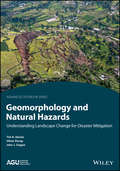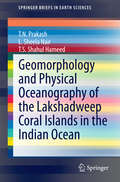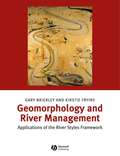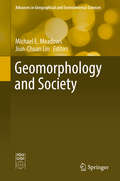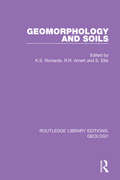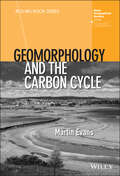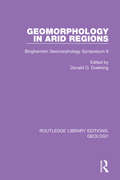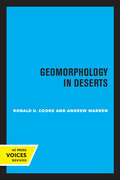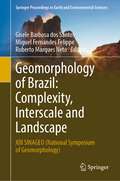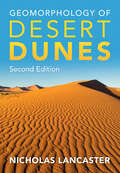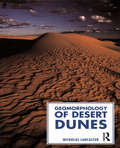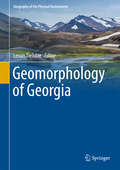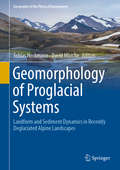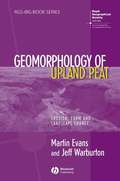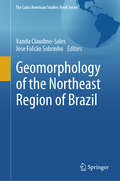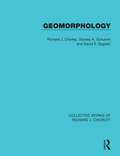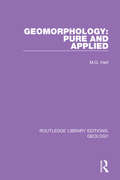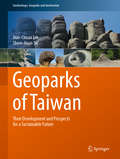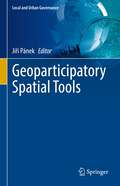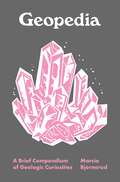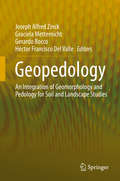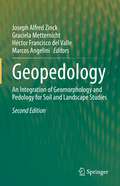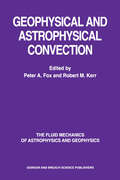- Table View
- List View
Geomorphology and Natural Hazards: Understanding Landscape Change for Disaster Mitigation (AGU Advanced Textbooks)
by John J. Clague Timothy R. Davies Oliver KorupNatural disasters are occasional intense events that disturb Earth's surface, but their impact can be felt long after. Hazard events such as earthquakes, volcanos, drought, and storms can trigger a catastrophic reshaping of the landscape through the erosion, transport, and deposition of different kinds of materials. Geomorphology and Natural Hazards: Understanding Landscape Change for Disaster Mitigation is a graduate level textbook that explores the natural hazards resulting from landscape change and shows how an Earth science perspective can inform hazard mitigation and disaster impact reduction. Volume highlights include: Definitions of hazards, risks, and disasters Impact of different natural hazards on Earth surface processes Geomorphologic insights for hazard assessment and risk mitigation Models for predicting natural hazards How human activities have altered 'natural' hazards Complementarity of geomorphology and engineering to manage threats
Geomorphology and Physical Oceanography of the Lakshadweep Coral Islands in the Indian Ocean
by T. N. Prakash L. Sheela Nair T.S. Shahul HameedThe Lakshadweep islands are a group of 36 coral islands in the Indian Ocean. These small islands are unique for their aquatic bio-diversity and vast blue lagoons. This book presents the results of studies done by the authors during the period 1990 to 2009 that address the beach morphology, hydrodynamics, energy resources and management options with special reference to the issue of both natural and anthropogenic coastal erosion. The relatively low island elevation makes the islands more susceptible to high-wave attack and coastal flooding during adverse weather conditions. The islands are also prone to risks from episodic events like cyclones and deep depressions. This highlights the need for a comprehensive study of the wave, climate and coastal processes at work during different seasons to delineate the factors responsible for shoreline changes and also to identify the locations that need protection and the management options. This book will serve as a guide to researchers, scholars and students who are interested in the coastal processes of coral islands.
Geomorphology and River Management: Applications of the River Styles Framework
by Gary J. Brierley Kirstie A. FryirsThis book outlines a generic set of procedures, termed the River Styles Framework, which provides a set of tools for interpreting river character, behavior, condition, and recovery potential. Applications of the framework generate a coherent package of geomorphic information, providing a physical template for river rehabilitation activities. management and restoration of rivers is a rapidly growing topic for environmental scientists, geologists and ecologists - this book provides a learning tool with which to approach geomorphic applications to river management describes the essential geomorphological principles underlying river behaviour and evolution demonstrates how the River Styles Framework can turn geomorphic theory into practice, to develop workable strategies for restoration and management based on real case studies and authors extensive experience applicable to river systems worldwide synthesises fluvial geomorphology, ecology and management
Geomorphology and Society
by Michael E. Meadows Jiun-Chuan LinThisbook deals with the relationship between geomorphology and society. This topic hashad rather scant treatment in the literature except to some extent under thelabel "applied geomorphology". In this text the authors aim to bring togetherconceptual issues and case studies of how geomorphology influences society and,indeed, how society is in turn influenced by geomorphology. In an age in whichthe influence of human activities on global environments has become soparamount that it is increasingly common to refer to it geologically as the "anthropocene",the book aims to reflect on the geomorphological significance of widespread anddiverse forms of human impact in a range of environmental settings.
Geomorphology and Soils (Routledge Library Editions: Geology #16)
by K. S. RichardsSoils and sediments influence current processes, preserve evidence of past processes, indicate evolutionary phases in landscapes and provide a basis for relative and absolute chronologies. They provide an important key to the integration of short-term process studies and investigation of longer-term landform evolution. This book, first published in 1985, has been arranged to provide wide temporal and spatial coverage, with studies ranging from historic to geologic time scales and micro- to macro-spatial scales. The interdisciplinary nature of the subject is reflected in contributions from soil scientists, engineering geologists, hydrologists and geomorphologists.
Geomorphology and the Carbon Cycle (RGS-IBG Book Series)
by Martin EvansThe first systematic examination of the role of geomorphological processes in the cycling of carbon through the terrestrial system. Argues that knowledge of geomorphological processes is fundamental to understanding the ways in which carbon is stored and recycled in the terrestrial environment Integrates classical geomorphological theory with understanding of microbial processes controlling the decomposition of organic matter Develops an interdisciplinary research agenda for the analysis of the terrestrial carbon cycle Informed by work in ecology, microbiology and biogeochemistry, in order to analyse spatial and temporal patterns of terrestrial carbon cycling at the landscape scale Considers the ways in which, as Humanity enters the Anthropocene, the application of this science has the potential to manage the terrestrial carbon cycle to limit increases in atmospheric carbon
Geomorphology in Arid Regions: Binghamton Geomorphology Symposium 8 (Routledge Library Editions: Geology #17)
by Donald O. DoehringThis book, first published in 1980, collects together thirteen articles on ‘Geomorphology in Arid Regions’. It uses the term ‘arid’ loosely to include studies from climes which might otherwise be considered semi-arid, in order to provide a diversity of papers dealing with important problems of interest to geomorphologists today.
Geomorphology in Deserts
by Andrew Warren Ronald U. CookeThis title is part of UC Press's Voices Revived program, which commemorates University of California Press’s mission to seek out and cultivate the brightest minds and give them voice, reach, and impact. Drawing on a backlist dating to 1893, Voices Revived makes high-quality, peer-reviewed scholarship accessible once again using print-on-demand technology. This title was originally published in 1973.
Geomorphology in the Anthropocene
by Andrew S. Goudie Viles Heather A.The Anthropocene is a major new concept in the Earth sciences and this book examines the effects on geomorphology within this period. Drawing examples from many different global environments, this comprehensive volume demonstrates that human impact on landforms and land-forming processes is profound, due to various driving forces, including: use of fire; extinction of fauna; development of agriculture, urbanisation, and globalisation; and new methods of harnessing energy. The book explores the ways in which future climate change due to anthropogenic causes may further magnify effects on geomorphology, with respect to future hazards such as floods and landslides, the state of the cryosphere, and sea level. The book concludes with a consideration of the ways in which landforms are now being managed and protected. Covering all major aspects of geomorphology, this book is ideal for undergraduate and graduate students studying geomorphology, environmental science and physical geography, and for all researchers of geomorphology.
Geomorphology of Brazil: XIII SINAGEO (National Symposium of Geomorphology) (Springer Proceedings in Earth and Environmental Sciences)
by Gisele Barbosa dos Santos Miguel Fernandes Felippe Roberto Marques NetoThis book presents the most relevant articles selected from the annals of the symposium. In the last few years, Brazilian Geomorphology has experienced a series of epistemological and methodological innovations expressed by the incorporation of the complexity paradigm, by the progressive break with the climate paradigm, by the emergency role of new theories, and by the advances in methodological fields favored by the adherence to geochronological techniques and in function of the increasingly widespread use of geotechnologies. Furthermore, the Anthropocene/Technogene emerge claims to be more than only a temporal cuts, but as conceptions of a science engaged with social and environmental issues. The National Symposium of Geomorphology, in the maturity of its 13th edition, constitutes a portrait and an important sample of Brazilian geomorphological production, aggregating works carried out in the most diverse types of landscapes of Brazil. The book provides an overview of the current scientific production of Brazilian Geomorphology, highlighting the diversity of landscapes and geoheritage in Brazil, the complexity of the morphogenetic and morphodynamic processes responsible for shaping its surface, and the various abundant methodologies used in geomorphological studies in tropical areas.
Geomorphology of Desert Dunes
by Nicholas LancasterSand dunes are a globally important depositional landform and sedimentary system. Their origins and dynamics are important in understanding how deserts have evolved in response to climate change and changes in sand supply and mobility, and how they will continue to evolve in the future. This book provides a state-of-the-art review of the characteristics of desert dunes and their sediments, and explores their dynamics on timescales from days to millennia as they respond to changes in wind speed and direction, precipitation and sand supply. This extensively revised edition reflects the advances in our understanding of desert dunes, their dynamics and history; and covers recent developments including the luminescence dating revolution, ground penetrating radar and advances in numerical modeling. Also covering dunes on Mars and Titan, this authoritative reference is a must-have for researchers and graduate students working on desert dunes and aeolian geomorphology.
Geomorphology of Desert Dunes
by Nicholas LancasterFirst published in 2004. Routledge is an imprint of Taylor & Francis, an informa company.
Geomorphology of Georgia (Geography of the Physical Environment)
by Levan TielidzeThis book provides a comprehensive overview of the geomorphology of Georgia. It describes a country characterized by geological, geomorphological and geographical diversities, located in the Caucasus region at the crossroads of Europe and Asia. This book is based on the results of several years of geomorphological studies and research in Georgia, published for the first time in English, and covers a gap in research in the field of world regional geomorphology. The landscapes of Georgia consist of high glacial mountains, medium and high mountains with deeply fragmented features, narrow and deep gorges and canyons, seaside lowlands, volcanic cones, uplands and mountain ranges, intermountain plains, hollows and highlands. The peculiarity of the landscape greatly affects the natural conditions. In several chapters, this book describes the diversity of climate, hydrographic network, vegetation cover, soils, fauna, exogenic processes, natural and anthropogenic landscapes. This volume provides the readers with the opportunity to explore the variety of landscapes and landforms in this diverse and fascinating country through informative texts illustrated with many color maps and photographs. Geomorphology of Georgia appeals to scientists, scholars, teachers and any readers interested in geology, physical geography, geomorphology, tourism and environmental protection. It is a rich resource for field trips and a comprehensive guide for travelers interested in the geomorphology of Georgia.
Geomorphology of Proglacial Systems: Landform and Sediment Dynamics in Recently Deglaciated Alpine Landscapes (Geography of the Physical Environment)
by Tobias Heckmann David MorcheThis book discusses the recession of alpine glaciers since the end of the Little Ice Age (LIA), which has been accelerating in the past decades. It provides an overview of the research in the field, presenting definitions and information about the different proglacial areas and systems. A number of case studies are from the PROSA project group which encompasses the expertise of geomorphologists, geologists, glaciologists and geodesists. The PROSA joint project (High-resolution measurements of morphodynamics in rapidly changing PROglacial Systems of the Alps) is determined to tackle the problems of geomorphic activity on sediment export through a quantification of sediment fluxes effected by the aforementioned geomorphic processes within the forefield of the Gepatschferner glacier (Central Alps, Austria).
Geomorphology of Upland Peat: Erosion, Form and Landscape Change (RGS-IBG Book Series #70)
by Jeff Warburton Martin EvansThe Geomorphology of Upland Peat offers a detailed synthesis of existing literature on peat erosion, incorporating new research ideas and data from two leading experts in the field. Presents the most detailed and current work to date Written in a style that is both intelligent and accessible Fully illustrated with original drawings and photographs Relevant and information for a broad audience working on organic sediments in various environments
Geomorphology of the Northeast Region of Brazil (The Latin American Studies Book Series)
by Vanda Claudino-Sales José Falcão SobrinhoThe Brazilian Northeast, comprising 1,600,000 km2 and nine States (Alagoas, Bahia, Ceará, Maranhão, Paraíba, Pernambuco, Piauí, Rio Grande do Norte, Sergipe), has an enormous diversity of geomorphological landscapes. Despite the wealth of relief, the available studies do not present, in detail, the regional geomorphological elements. However, it is necessary to allow the advancement of geographic science and related areas, create appropriate processes for the use and occupation of geographic space, guide land-use planning and environmental planning, and encourage conservationist practices. The chapters, written by the best geomorphological specialists in each segment, present unique, rich, and unpublished material that treats the reality of the geomorphological landscape in the Brazilian Northeast. It starts with a theoretical discussion on advances in the analysis of geomorphology by State, showing an unprecedented and functional geographic division.
Geomorphology: Or The Study Of Geomorphology (Collected Works of Richard J. Chorley)
by Richard J. Chorley Stanley A. Schumm David E. SugdenOriginally published in 1984. This major text covers the whole discipline of geomorphology, presenting a clear and comprehensive overview of the field, drawing on the full range of modern research. Landforms and their formative processes are treated on a broad spectrum of spatial scales, and examples are drawn from the major geological, climatic and biotic environments. The book is divided conveniently into some 170 clearly defined sections to allow readers to make the most efficient use of those parts of the text relevant to their particular needs. After introducing the basic concepts such as systems analysis, morphologic and cascading systems, the historical-evolutionary approach and process-response geomorphology, the book moves on to the geological background to geomorphology and then the extensive third part deals with the geomorphic processes and responding landforms. Part four examines climatic geomorphology and the appendix touches on applied geomorphology, especially fluvial processes.
Geomorphology: Pure and Applied (Routledge Library Editions: Geology #13)
by M.G. HartThis unique treatment of geomorphology, first published in 1986, provides a comprehensive work to enable students to see the subject as a whole. Taking the concepts that run through the subject and cut across its standard divisions, the book summarises the history of intellectual debate in geomorphology and then describes modern developments, both pure and applied.
Geoparks of Taiwan: Their Development and Prospects for a Sustainable Future (Geoheritage, Geoparks and Geotourism)
by Jiun-Chuan Lin Shew-Jiuan SuThis book offers an essential introduction to Taiwan’s geoparks, issues related to their development, and prospects for a sustainable future. It discusses how promoting geoparks can serve as a tool for a sustainable society based on the lessons learned in Taiwan. Situated in a tectonically dynamic geological setting (at the boundary of the Eurasian and the Philippine Plates) and culturally diversified geographical setting, Taiwan is an ideal candidate for showcasing its “natural wonders” in geoparks, promoting landscape conservation, and expanding the horizons of geoheritage world-wide. The book begins by illustrating the physical and human environments of Taiwan’s geoparks, helping readers understand their foundation. In turn, the second section includes chapters describing the development of all six Taiwanese geoparks, offering comprehensive information on each. Lastly, it illustrates the social development and mechanisms used to promote each geopark.
Geoparticipatory Spatial Tools (Local and Urban Governance)
by Jiří PánekThe book explores the key factors affecting the successful implementation of public participation spatial systems in participatory planning as part of the urban governance system. It brings insight from nation-wide research in the Czech Republic and the implications to other countries in the region and beyond. The main aim of the proposed book is to analyse the state-of-the-art of using geoparticipatory tools for citizens’ participation in community decision-making process and to suggest the effective implementation of the geoparticipatory tools available in urban governance. This book explores the situation in the Czech Republic as a representative of for Eastern Bloc country, three decades after the political transition, on its way to public participation in local and urban governance. The active involvement of the citizens into the local and urban decision making process via geoparticipatory spatial tools is becoming a popular research field among human geographers, behavioural geographers, GIS scientists, environmental psychologists, policy scientists and many others scientific areas.
Geopedia: A Brief Compendium of Geologic Curiosities (Pedia Books #6)
by Marcia BjornerudA garden of geologic delights for all EarthlingsGeopedia is a trove of geologic wonders and the evocative terms that humans have devised to describe them. Featuring dozens of entries—from Acasta gneiss to Zircon—this illustrated compendium is brimming with lapidary and lexical insights that will delight rockhounds and word lovers alike.Geoscientists are magpies for words, and with good reason. The sheer profusion of minerals, landforms, and geologic events produced by our creative planet demands an immense vocabulary to match. Marcia Bjornerud shows how this lexicon reflects not only the diversity of rocks and geologic processes but also the long history of human interactions with them.With wit and warmth, she invites all readers to celebrate the geologic glossary—a gallimaufry of allusions to mythology, imports from diverse languages, embarrassing anachronisms, and recent neologisms. This captivating book includes cross-references at the end of each entry, inviting you to leave the alphabetic trail and meander through it like a river. Its pocket-friendly size makes it the perfect travel companion no matter where your own geologic forays may lead you.With whimsical illustrations by Haley Hagerman, Geopedia is a mix of engaging and entertaining facts about how the earth works, how it has coevolved with life over billions of years, and how our understanding of the planet has deepened over time.Features a real cloth cover with an elaborate foil-stamped design
Geopedology
by Joseph Alfred Zinck Graciela Metternicht Gerardo Bocco Héctor Francisco Del ValleThis book offers a proven approach for reliable mapping of soil-landscape relationships to derive information for policy, planning and management at scales ranging from local to regional. It presents the theoretical and conceptual framework of the geopedologic approach and a bulk of applied research showing its application and benefits for knowledge generation relevant to geohazard studies, land use conflict analysis, land use planning, land degradation assessment, and land suitability analysis. Soil is a vital resource for society at large and an important determinant of the economic status of nations. The intensification of natural disasters and the increased land use competition for food and energy have raised awareness of the relevant role the pedosphere plays in natural and anthropogenic environments. Recent papers and global initiatives show a renewed interest in soil research and its applications for improved planning and management of this fragile and finite resource.
Geopedology: An Integration Of Geomorphology And Pedology For Soil And Landscape Studies
by Joseph Alfred Zinck Graciela Metternicht Héctor Francisco del Valle Marcos Angelini<p>This updated and revised second edition brings geopedology issues into the current context. This new edition extends the work on popular topics such as digital soil mapping, GIS and landscape mapping, and it also gives valuable insight with up-to-date theoretical discussions and new application with relevant case studies. This textbook offers a proven approach for reliable mapping of soil-landscape relationships to derive information for policy, planning and management at scales ranging from local to regional. Filled with didactic elements such as case studies, visual aids (maps, charts and figures), questions and answers, the book is of interest to geohazard studies, land use conflict analysis, land use planning, land degradation assessment, and land suitability analysis.<p> <p>Soil is a vital resource for society at large and an important determinant of the economic status of nations. The intensification of natural disasters and the increased land use competition for food and energy have raised awareness of the relevant role the pedosphere plays in natural and anthropogenic environments. Recent papers and global initiatives show a renewed interest in soil research and its applications for improved planning and management of this fragile and finite resource.<p>
Geopedology: An Integration of Geomorphology and Pedology for Soil and Landscape Studies
by Joseph Alfred Zinck Graciela Metternicht Héctor Francisco del Valle Marcos AngeliniThis updated and revised second edition brings geopedology issues into the current context. This new edition extends the work on popular topics such as digital soil mapping, GIS and landscape mapping, and it also gives valuable insight with up-to-date theoretical discussions and new application with relevant case studies. This textbook offers a proven approach for reliable mapping of soil-landscape relationships to derive information for policy, planning and management at scales ranging from local to regional. Filled with didactic elements such as case studies, visual aids (maps, charts and figures), questions and answers, the book is of interest to geohazard studies, land use conflict analysis, land use planning, land degradation assessment, and land suitability analysis. Soil is a vital resource for society at large and an important determinant of the economic status of nations. The intensification of natural disasters and the increased land use competition for food and energy have raised awareness of the relevant role the pedosphere plays in natural and anthropogenic environments. Recent papers and global initiatives show a renewed interest in soil research and its applications for improved planning and management of this fragile and finite resource.
Geophysical & Astrophysical Convection (The Fluid Mechanics of Astrophysics and Geophysics)
by Robert M. Kerr Peter A. FoxGeophysical and Astrophysical Convection collects important papers from an international group of the world's foremost researchers in geophysical and astrophysical convection to present a concise overview of recent thinking in the field. Topics include: Atmospheric convection, solar and stellar convection, unsteady non-penetrative thermal convectio
